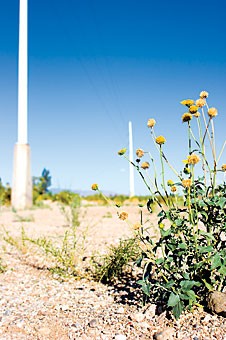Research conducted by UA researchers over the last two years has doubled the previous knowledge researchers had about climate variability in the Upper Colorado River Basin.
A recent project conducted in the basin by members of the UA Laboratory of Tree-Ring Research to reconstruct historic stream flow has expanded the known record to the year 762, more than doubling the length of information previously known about the area (about the year 1400), said Dave Meko, associated research professor at the lab.
Included in the findings is the discovery of a drought that lasted 62 years in the 1100s. During this time, the Colorado River was running at a level below normal, and thus the period was marked by a series of dry years.
This knowledge can now help water managers predict water flow and different ways to handle droughts when they occur, Meko said, which is particularly important because the area is currently in a drought.
“”It’s not enough to tell water managers it was dry for so long,”” Meko said, adding that they want to know how dry it was and what could tweak the climate system to cause such a long drought.
The lab’s role in that dialogue is to give water managers the most accurate picture of climate variability, Meko said.
A tree ring measures one year of a tree’s life. Measuring and observing these rings helps dendrochronologists, or tree-ring scientists, to more accurately determine things such as what the climate was like in a given location and how old an archaeological site is.
Tree rings can pinpoint an archaeological site down to the exact year, according to the tree-ring lab’s Web site.
Tree-ring research gives people a long-term picture of climate change, rather than the relative snapshot of 100 years or so from the instrumental records, Meko said.
To get this larger picture, he said, the research team had to take core samples from living trees and match up the rings with samples of older, dead trees in a chain until it formed a record all the way back to 762.
The oldest sample, a piece of a Douglas fir tree, was dated at 323 B.C.E. (before common era), although it was not included in the research’s findings.
“”We happened to be fabulously lucky to find samples that old,”” Meko said.
The research process, from securing funding to publishing the findings in Geophysical Research Letters, took only two years, Meko said.
This is quite a short amount of time for research and has been shortened by
work the lab already did on the basin’s watershed, said Christopher Baisan, a senior research specialist in the tree-ring lab.
The Upper Colorado River Basin includes parts of Wyoming, Utah, Colorado, New Mexico and Arizona, according to a United States Geological Survey Web site. Most of Arizona is in the lower basin.
“”Everything we do builds on stuff we’ve done before,”” Baisan said.
Students also had a hand in the research conducted.
Troy Knight, a UA doctorate candidate in geography, went with Baisan and Meko to collect wood samples.
Knight sanded the cross-sections in the lab to clearly reveal the rings and cross dated them “”by matching ring width patterns in overlapping pieces of wood beginning with trees that were living at the time of collection,”” he wrote in an e-mail.
“”This type of field work is fun,”” Knight wrote. “”I was not prepared for the sheer age of the material we collected over the past two years.””









